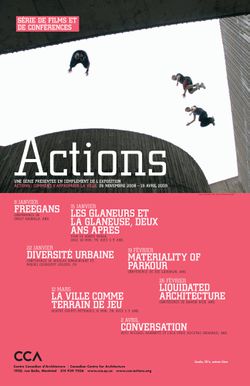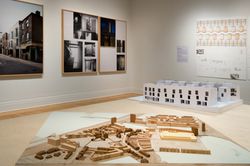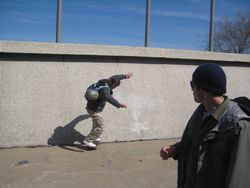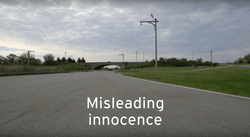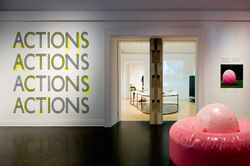Sous-série
AP075.S3.SS2
Description:
This sub-series documents Cornelia Hahn Oberlander's administrative records of her practice as landscape architect from the end of the 1950s to the end ot the 2010s. It comprises material related to her consulting services on her own various landscape projects and urban planning projects, and also her consulting services for projects submitted as member of a larger project team for private or public projects. Her office records also contains documents related the planning of her work, her patents applications and designs for her own landscape or playground furnitures, and her professional correspondence. The sub-series also documents Oberlander press and promotional activities, such as interviews she gave, articles written about her, about her work as landscape architect, her statements or her activism for social and environmental causes or preservation landmark buildings and spaces. The sub-series contains documents related to Oberlander's consulting services, including requests for services, proposals by her or by the project team, correspondence, or documentation collected for projects calls of interest to Oberlander. Oberlander's office records for planning of projects and other activities includes professional correspondence files, agendas and planners, message books and notebooks, patents applications and plans for her designs, and office references, such landscape architecture regulations and guidelines, and landscape specifications templates. The sub-series also comprises promotional material, such as photographs of her previous projects, press clippings of articles or periodicals with articles about her or her work, promotional panels for some of her major projects, and brochures or leaflets on her most well known projects. It includes also contains recordings of interviews on TV or radio shows she gave, biographical information on Oberlander, versions of her CV's, portaits of her, and lists and project write-ups.
1953-2018
Administrative records and promotional material
Actions:
AP075.S3.SS2
Description:
This sub-series documents Cornelia Hahn Oberlander's administrative records of her practice as landscape architect from the end of the 1950s to the end ot the 2010s. It comprises material related to her consulting services on her own various landscape projects and urban planning projects, and also her consulting services for projects submitted as member of a larger project team for private or public projects. Her office records also contains documents related the planning of her work, her patents applications and designs for her own landscape or playground furnitures, and her professional correspondence. The sub-series also documents Oberlander press and promotional activities, such as interviews she gave, articles written about her, about her work as landscape architect, her statements or her activism for social and environmental causes or preservation landmark buildings and spaces. The sub-series contains documents related to Oberlander's consulting services, including requests for services, proposals by her or by the project team, correspondence, or documentation collected for projects calls of interest to Oberlander. Oberlander's office records for planning of projects and other activities includes professional correspondence files, agendas and planners, message books and notebooks, patents applications and plans for her designs, and office references, such landscape architecture regulations and guidelines, and landscape specifications templates. The sub-series also comprises promotional material, such as photographs of her previous projects, press clippings of articles or periodicals with articles about her or her work, promotional panels for some of her major projects, and brochures or leaflets on her most well known projects. It includes also contains recordings of interviews on TV or radio shows she gave, biographical information on Oberlander, versions of her CV's, portaits of her, and lists and project write-ups.
Sub-series
1953-2018
Projet
AP164.S1.2004.D13
Description:
The project series documents the competition entry for a convention centre and an international fair in León, Spain. The competition by invitation only was organised by the León Town Council. Abalos & Herreros finished second. The firm identified this project as number 191. "Leon's Fair tries to give protagonism to old factories witch characterize the site making them up as principal access point and general services for the building, as well as creating a simple constructive space, similar to a tent. [...] Also the Congress Centre fill fair's core, the communication and leisure place with its small group of people's geometry. The project tries to compose these three pieces in a unique coherent group in its differences and resemblances, able to create a place with a clear sense: Leon’s Fair." Documenting the project are presentation drawings, project descriptions, competition documents, cartographic, graphic and reference materials, correspondence, specifications and publications.
2001-2005, predominant 2004-2005
Palacio de congresos y ferial internacional de León, Spain (2004)
Actions:
AP164.S1.2004.D13
Description:
The project series documents the competition entry for a convention centre and an international fair in León, Spain. The competition by invitation only was organised by the León Town Council. Abalos & Herreros finished second. The firm identified this project as number 191. "Leon's Fair tries to give protagonism to old factories witch characterize the site making them up as principal access point and general services for the building, as well as creating a simple constructive space, similar to a tent. [...] Also the Congress Centre fill fair's core, the communication and leisure place with its small group of people's geometry. The project tries to compose these three pieces in a unique coherent group in its differences and resemblances, able to create a place with a clear sense: Leon’s Fair." Documenting the project are presentation drawings, project descriptions, competition documents, cartographic, graphic and reference materials, correspondence, specifications and publications.
Project
2001-2005, predominant 2004-2005
Projet
CD034.S1.1974.PR01
Description:
This project series contains four reproductions of drawings displayed in the exhibit to document the neighbourhood Quinta do Bacalhau-Monte Coxo, in Lisbon, Portugal. The exhibit text explained the following: The project architect Manuel Vicente was already working on a design for the intervention in the Quintas de Bacalhau and Monte Coxo when he was co-opted by SAAL. The proposed typology referred to another ambitious urban project of 615 housing units, Quinta das Fonsecas - Quinta da Calçada neighbourhood by the architect Raúl Hestnes Ferreira. The intention was to bring the city to the outlying shanty town areas. None of these projects was carried out in full, and they are now fragmented and besieged by the traffic system without having produced any of the essential community and socialising facilities. In Bacalhau-Monte Coxo the structure of the internal patios reveals the ways in which the public space and community was organised. The architecture assigned importance to the facades, although access to the community courtyards was also a central design concept. In a 1976 interview, the architect himself argued that the release of bourgeois guilt allowed for spatial beauty, adopting the slogan 'Facades First' in defence of architectural design. In a way, this proposal anticipated the post-modern, although in a form that did not deny architecture's social engagement. The design emphasizes a strong idea of architectural autonomy, unfortunately only a part of the project was actually built. (The SAAL Process, Housing in Portugal 1974–76) Manuel Vicente worked for SAAL/Lisbon and Central South with the following collaborators: Afonso José Baptista, Agostinho Xavier de Andrade, António Albano Leitão, Cristina Catela Martins Pereira, Eduardo Serrano de Sousa, Gentil Noras, José Manuel Diniz Cabral Caldeira, Manuel Augusto Lopes de Sousa, Nuno Matos Silva, Rita Cabral and the resident association Cooperativa de Habitação Económica Portugal Novo, that was founded on September 6th, 1974. The team built 384 dwellings. The operation began in September 1974, with a construction date in January 1977. This project series contains reproductions of design development drawings and a cadastral plan. The original drawings were produced in 1974 or after and were reproduced in 2015 for the exhibit.
circa 1974
Bairro Quinta do Bacalhau–Monte Coxo, Lisbon
Actions:
CD034.S1.1974.PR01
Description:
This project series contains four reproductions of drawings displayed in the exhibit to document the neighbourhood Quinta do Bacalhau-Monte Coxo, in Lisbon, Portugal. The exhibit text explained the following: The project architect Manuel Vicente was already working on a design for the intervention in the Quintas de Bacalhau and Monte Coxo when he was co-opted by SAAL. The proposed typology referred to another ambitious urban project of 615 housing units, Quinta das Fonsecas - Quinta da Calçada neighbourhood by the architect Raúl Hestnes Ferreira. The intention was to bring the city to the outlying shanty town areas. None of these projects was carried out in full, and they are now fragmented and besieged by the traffic system without having produced any of the essential community and socialising facilities. In Bacalhau-Monte Coxo the structure of the internal patios reveals the ways in which the public space and community was organised. The architecture assigned importance to the facades, although access to the community courtyards was also a central design concept. In a 1976 interview, the architect himself argued that the release of bourgeois guilt allowed for spatial beauty, adopting the slogan 'Facades First' in defence of architectural design. In a way, this proposal anticipated the post-modern, although in a form that did not deny architecture's social engagement. The design emphasizes a strong idea of architectural autonomy, unfortunately only a part of the project was actually built. (The SAAL Process, Housing in Portugal 1974–76) Manuel Vicente worked for SAAL/Lisbon and Central South with the following collaborators: Afonso José Baptista, Agostinho Xavier de Andrade, António Albano Leitão, Cristina Catela Martins Pereira, Eduardo Serrano de Sousa, Gentil Noras, José Manuel Diniz Cabral Caldeira, Manuel Augusto Lopes de Sousa, Nuno Matos Silva, Rita Cabral and the resident association Cooperativa de Habitação Económica Portugal Novo, that was founded on September 6th, 1974. The team built 384 dwellings. The operation began in September 1974, with a construction date in January 1977. This project series contains reproductions of design development drawings and a cadastral plan. The original drawings were produced in 1974 or after and were reproduced in 2015 for the exhibit.
Project
circa 1974
Materiality of Parkour
Zoe Laughlin, ingénieure, artiste et théoricienne, s’exprime sur l’utilisation inédite des bâtiments et du mobilier urbain qu’engendre la pratique du parkour, une activité qui réinterprète le paysage urbain. Ses réflexions portent essentiellement sur la matérialité de la vie quotidienne, sur la manière dont se comporte la matière, sur ses qualités sensorielles, et sur la(...)
Théâtre Paul-Desmarais
19 février 2009
Materiality of Parkour
Actions:
Description:
Zoe Laughlin, ingénieure, artiste et théoricienne, s’exprime sur l’utilisation inédite des bâtiments et du mobilier urbain qu’engendre la pratique du parkour, une activité qui réinterprète le paysage urbain. Ses réflexions portent essentiellement sur la matérialité de la vie quotidienne, sur la manière dont se comporte la matière, sur ses qualités sensorielles, et sur la(...)
Théâtre Paul-Desmarais
Cette exposition se consacre aux projets architecturaux récents de Stephen Taylor à Londres et de Ryue Nishizawa à Tokyo, qui proposent de nouvelles approches de la vie en milieu urbain. Perspectives de vie à Londres et à Tokyo imaginées par Stephen Taylor et Ryue Nishizawa marque la première présentation en Amérique du Nord des projets résidentiels de Taylor et Nishizawa(...)
Salles principales
14 mai 2008 au 26 octobre 2008
Perspectives de vie à Londres et à Tokyo imaginées par Stephen Taylor et Ryue Nishizawa
Actions:
Description:
Cette exposition se consacre aux projets architecturaux récents de Stephen Taylor à Londres et de Ryue Nishizawa à Tokyo, qui proposent de nouvelles approches de la vie en milieu urbain. Perspectives de vie à Londres et à Tokyo imaginées par Stephen Taylor et Ryue Nishizawa marque la première présentation en Amérique du Nord des projets résidentiels de Taylor et Nishizawa(...)
Salles principales
Le planchiste et architecte-paysagiste Mathieu Robichaud invite les participants à une visite guidée et analyse les opportunités qu’offrent les espaces urbains traversés pour la pratique de la planche à roulettes. Robichaud, de la firme Bloom Paysage, se spécialise dans la conception de parcs dédiés à la pratique de la planche à roulettes. En complément de l’exposition(...)
11 avril 2009
Découvrir les lieux propices à la pratique de la planche à roulettes
Actions:
Description:
Le planchiste et architecte-paysagiste Mathieu Robichaud invite les participants à une visite guidée et analyse les opportunités qu’offrent les espaces urbains traversés pour la pratique de la planche à roulettes. Robichaud, de la firme Bloom Paysage, se spécialise dans la conception de parcs dédiés à la pratique de la planche à roulettes. En complément de l’exposition(...)
Projet
CI005.S1.1921.PR1
Description:
German architectural critic, Adolf Behne, requested Oud submit a design for a private house that was to be built for private clients in Berlin-Grünewald in 1921. Although Oud's designs never came to fruition, the project promoted his international reputation, with his designs circulating in lectures and publications. Behn, who maintained a correspondence with Oud, helped introduce Oud to the international scene with a positive review of his designs, including one for Villa Kallenbach. Oud's design was in stark contrast to the prevailing contemporary German aesthetic of Expressionism. Oud created a functional symmetric design for a detached, spacious country dwelling; he placed the building toward the anterior of the site and angled the front away from the street to take advantage of the sunlight and garden space (Taverne et al. 2001, 312-317). Oud made some modifications based on the client's desire to enlarge the ground floor in February, 1922. Project series includes drawings of plans and elevations.
1921-1922
Project for the Kallenbach House, Berlin, Germany (1921-1922)
Actions:
CI005.S1.1921.PR1
Description:
German architectural critic, Adolf Behne, requested Oud submit a design for a private house that was to be built for private clients in Berlin-Grünewald in 1921. Although Oud's designs never came to fruition, the project promoted his international reputation, with his designs circulating in lectures and publications. Behn, who maintained a correspondence with Oud, helped introduce Oud to the international scene with a positive review of his designs, including one for Villa Kallenbach. Oud's design was in stark contrast to the prevailing contemporary German aesthetic of Expressionism. Oud created a functional symmetric design for a detached, spacious country dwelling; he placed the building toward the anterior of the site and angled the front away from the street to take advantage of the sunlight and garden space (Taverne et al. 2001, 312-317). Oud made some modifications based on the client's desire to enlarge the ground floor in February, 1922. Project series includes drawings of plans and elevations.
project
1921-1922
Ce film, conçu par Francesco Garutti et dirigé par Shahab Mihandoust, explore l’histoire de la conception d’un ensemble de ponts autoroutiers, commandés dans les années 1920 et 1930 par Robert Moses. L’histoire suggère que ces ponts autoroutiers aient été délibérément conçus pour empêcher le passage d’autobus de sorte que seules les voitures – et les personnes ayant les(...)
août 2014
Misleading Innocence (tracing what a bridge can do)
Actions:
Description:
Ce film, conçu par Francesco Garutti et dirigé par Shahab Mihandoust, explore l’histoire de la conception d’un ensemble de ponts autoroutiers, commandés dans les années 1920 et 1930 par Robert Moses. L’histoire suggère que ces ponts autoroutiers aient été délibérément conçus pour empêcher le passage d’autobus de sorte que seules les voitures – et les personnes ayant les(...)
Des architectes, des artistes et des collectifs en provenance de plusieurs pays redéfinissent des activités en apparence anodines comme le jardinage, le recyclage, le jeu ou la marche. Confrontées aux normes de comportement urbain communément admises, leurs actions vont parfois jusqu’à défier les prescriptions de la loi. Les groupes ou les individus mis en scène dans(...)
Salles principales
26 novembre 2008 au 19 avril 2009
Actions : comment s’approprier la ville
Actions:
Description:
Des architectes, des artistes et des collectifs en provenance de plusieurs pays redéfinissent des activités en apparence anodines comme le jardinage, le recyclage, le jeu ou la marche. Confrontées aux normes de comportement urbain communément admises, leurs actions vont parfois jusqu’à défier les prescriptions de la loi. Les groupes ou les individus mis en scène dans(...)
Salles principales
